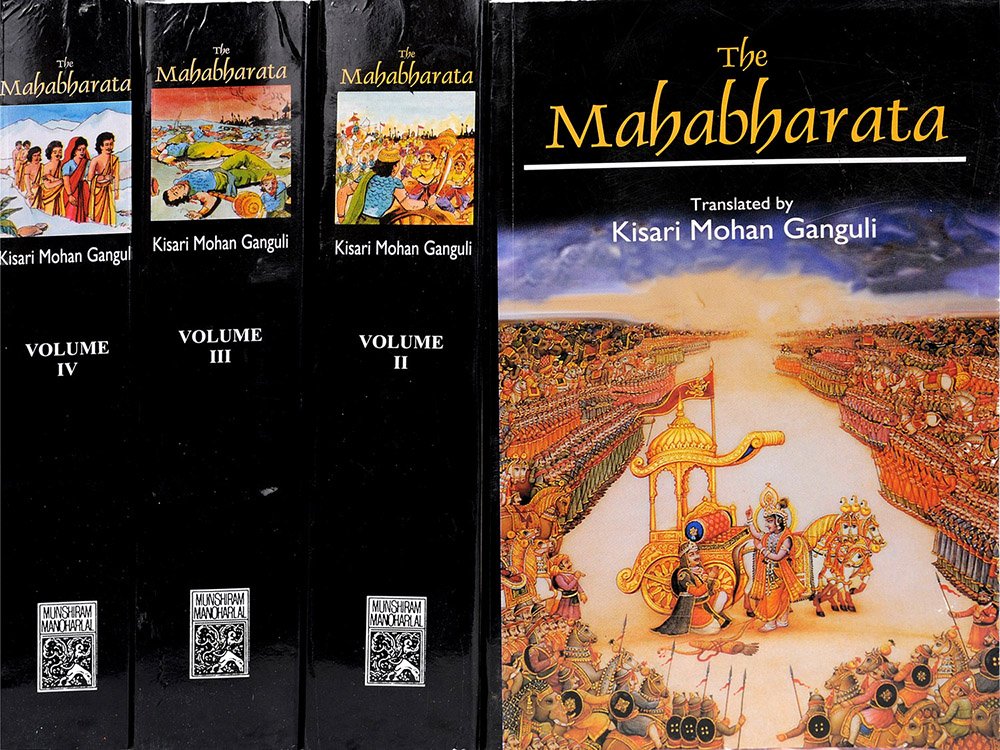Mahabharata (English)
by Kisari Mohan Ganguli | 2,566,952 words | ISBN-10: 8121505933
The English translation of the Mahabharata is a large text describing ancient India. It is authored by Krishna-Dwaipayana Vyasa and contains the records of ancient humans. Also, it documents the fate of the Kauravas and the Pandavas family. Another part of the large contents, deal with many philosophical dialogues such as the goals of life. Book...
Section X
"Dhritarashtra said,—
'Tell me, O Sanjaya, of the period of life, the strength, the good and bad things, the future, past and present, of the residents, O Suta, of this Varsha of Bharata, and of the Himavat-varsha, as also of Hari-varsha, in detail."
"Sanjaya said,—
'O bull of Bharata’s race, four Yugas set in Bharata’s Varsha, viz., Krita, Treta, Dvapara, and Kali. The Yuga that sets in first is Krita. O Lord; after the expiry of Krita comes Treta; after expiry of Treta comes Dvapara; and after that last of all, sets in Kali. Four thousand years, O best of the Kurus, are reckoned as the measure of life, O best of kings, in the Krita epoch. Three thousand years is the period in Treta, O ruler of men.
At present in Dvapara, persons live on Earth for two thousand years. In Kali, however, O bull of Bharata’s race, there is no fixed limit of life’s measure, in so much that men die while in the womb, as also soon after birth.
In the Krita age, O king, men are born and beget children, by hundreds and thousands, that are of great strength and great power, endued with the attribute of great wisdom, and possessed of wealth and handsome features. In that age are born and begotten Munis endued with wealth of asceticism, capable of great exertion, possessed of high souls, and virtuous, and truthful in speech. The Kshatriyas also, born in that age are of agreeable features, able-bodied, possessed of great energy, accomplished in the use of the bow, highly skilled in battle and exceedingly brave.
In the Treta age, O king, all the Kshatriya kings were emperors ruling from sea to sea. In Treta are begotten brave Kshatriyas not subject to any one, endued with long lives, possessed of heroism, and wielding the bow in battle with great skill.
When Dvapara sets in, O king, all the (four) orders born become capable of great exertion, endued with great energy, and desirous of conquering one another.
The men born in Kali, O king, are endued with little energy, highly wrathful, covetous, and untruthful. Jealousy, pride, anger, deception, malice and covetousness, O Bharata, are the attributes of creatures in the Kali age.
The portion that remains, O king, of this the Dvapara age, is small, O ruler of men. The Varsha known as Haimavat is superior to Bharatavarsha, while Harivarsha is superior to Hainavatvarsha, in respect of all qualities.'
Conclusion:
This concludes Section X of Book 6 (Bhishma Parva) of the Mahabharata, of which an English translation is presented on this page. This book is famous as one of the Itihasa, similair in content to the eighteen Puranas. Book 6 is one of the eighteen books comprising roughly 100,000 Sanskrit metrical verses.
FAQ (frequently asked questions):
Which keywords occur in Section X of Book 6 of the Mahabharata?
The most relevant definitions are: Treta, Varsha, Bharata, Krita, Dvapara, Kali; since these occur the most in Book 6, Section X. There are a total of 19 unique keywords found in this section mentioned 49 times.
What is the name of the Parva containing Section X of Book 6?
Section X is part of the Jambukhanda Nirmana Parva which itself is a sub-section of Book 6 (Bhishma Parva). The Jambukhanda Nirmana Parva contains a total of 10 sections while Book 6 contains a total of 3 such Parvas.
Can I buy a print edition of Section X as contained in Book 6?
Yes! The print edition of the Mahabharata contains the English translation of Section X of Book 6 and can be bought on the main page. The author is Kisari Mohan Ganguli and the latest edition (including Section X) is from 2012.
